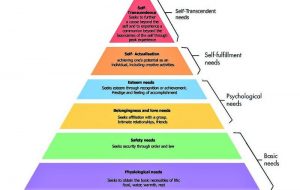Maslow’s hierarchy of needs
Maslow's pyramid or Maslow's hierarchy of needs is a motivational theory used in the area of psychology that comprises a five-level model based on different human needs, often represented as hierarchical levels within a pyramid. Maslow stated that people are motivated to achieve certain needs and that some needs take priority over others. Our most basic need is physical survival, and this will be the first thing that motivates our behavior. Once that level is reached, the next level is what motivates us to reach the next level, and so on.

Related topics
Personal development, happiness, motivation
What is Maslow's hierarchy of needs?
The pyramid of Maslow or Maslow's hierarchy of needs is a theory proposed by Abraham Maslow that says that as different basic needs are satisfied, human beings develop more needs and desires.
About Maslow’s hierarchy of needs
This pyramid model consists of five stages that can be divided according to the deficiency and growth needs of the human being. The first four levels are often called deficiency needs and the upper level is known as growth level. These deficiency needs arise from deprivation and are said to motivate people when they are not satisfied. In addition, the motivation to meet such needs will become stronger the longer the denial lasts. For example, the longer a person goes without food, the hungrier he or she will be. When a deficit need has been partly met, it will disappear, and our activities will usually be oriented toward the next set of needs that we still have to meet. These then become our main needs. However, growth needs continue and may become stronger once a commitment has been made to meet them. According to Maslow, the growth needs that arise do not come from a lack of something, but from a desire to grow as a person. Once these growth needs have been reasonably met, one can reach the highest level called self-actualization.
Characteristics of Maslow’s hierarchy of needs
- Needs that have not been met in behavior are included in the pyramid.
- Physiological needs are born with people and other needs arise throughout life.
- As basic needs are controlled, new needs of a higher order arise.
- Not all individuals have self-realization
- Basic needs need a short motivation
- Higher needs need a longer motivation
Needs
The main needs that human beings have according to Maslow’s hierarchy of needs are:
- Basic needs: These are the basic physiological needs necessary to maintain homeostasis and health; among them we can mention:
- Need to breathe, drink water, and eat.
- Need to maintain the balance of pH and body temperature.
- Need to sleep, rest and eliminate toxic waste from the body.
- Need to avoid pain and have sex.
- Security and protection need: arise once physiological needs have been and remain compensated. They are the needs that man has to feel safe and protected, within them we find:
- Physical and health security.
- Security of having decent employment, good income and resources.
- Moral, family and private property security.
- Needs of affiliation and affection: These are closely related to the affective development of each individual, and can be met through sporting, cultural and recreational activities, because man has the need to relate and be part of a community, then we can say that they are the needs of:
- Association
- Participation
- Accept
- Esteem needs: In this regard, Maslow described two types of esteem needs, a high esteem that implies the need for self-respect and includes feelings such as trust, achievement, independence, and freedom; and a low esteem that implies issues related to respect, such as the need for attention, recognition, reputation, fame, and mastery. Low self-esteem and inferiority complexes occur when these needs are diminished.
The last level belongs to the need for self-realization or self-actualization and is a psychological need that is at the top of the needs. The human being achieves this level when he is able to satisfy all the other levels.
Criticism of Maslow’s hierarchy of needs
The criticisms that have arisen and that have been made with respect to Maslow’s hierarchy of needs revolve around the fact that for many it is very complicated as far as its operability is concerned. Some experts insist that there is no proof that all people have the capacity to become self-fulfilling beings. There are those who think that their theory and concepts are obsolete because they only study the basic needs of the individual, but not of the individual made society. For some, happiness is a concept that can be achieved, but for others, it is merely a utopian concept.
Examples
A real-life example would be a child who at the beginning of his life was hungry and cold, but his parents find good jobs and begin to have access to meet their basic needs. Sometime later, the child grows up in an unsafe neighborhood, so his parents buy a house in a better neighborhood. Once there, he feels alone and without friends, but after a few days he is accepted by his classmates. He is not very agile in sports and is afraid of failing, but with time, he succeeds in the basketball team. Over time, he becomes a famous sportsman, which allows him to be admired by the world and end up satisfied with his achievements, so he is able to value everything he has achieved.
How to cite this article?
Briceño V., Gabriela. (2019). Maslow’s hierarchy of needs. Recovered on 3 January, 2025, de Euston96: https://www.euston96.com/en/maslows-hierarchy-of-needs/









